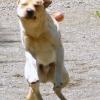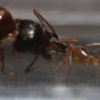My Aphaenogaster colony appears to be thriving. The colony has more than doubled since they were relocated from the wild to the Omni Nest Large in June 2017.
They were found in a rotting White Birch limb about two and a half inches in diameter, and about 12 inches long. I stumbled upon them in their Birch limb nest lying on a carpet of moss, among a stand of Cedar trees, in a mostly hardwood forest, in a river valley of the western Maine mountains.
They were placed into a ten gallon glass tank with a three eights poly tube connecting the tank to an Ants Canada “Omni Nest Large”. Once I removed the white paper bark from rotted Birch limb, the angry worker ants (200 -300) found the darkened Omni Nest and quickly moved the queen and a pile of eggs and larva in to their future home.
The Omni Nest is located in an unheated basement next to an overhead garage door that remains open most days during the summer months; so the environment outside the Omni Nest is very close to that of the outdoors. The Omni Nest remains connected to the ten gallon tank as their outworld.
Since June 2017 the brood has developed into a colony that is got to be over eight hundred strong; the queen, laying eggs continually. The Colony has thrived on:
Cellar Spiders
Grass Spiders
Grass Veneer Moths
Crickets (Sometimes)
Ham
Chicken
Scrambled Egg
Honey Nut Cheerios
Apple
Peach
Jello
Graham Crackers
Vanilla Wafer Cookies
Honey
Sugar Water
Carrot
Today I am preparing a space in the basement that can remain unheated as we start heating that lower level of our home. This space will never freeze, but should other wise should remain close to the temps outdoors. As the colder temps have begun to set in the colony has become less active and started to hoard food in the Omni Nest. I assume that once I isolate the nest from the basement environment they will hibernate very soon.




















